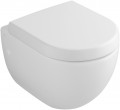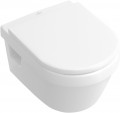Rimless
Toilets of special design, in which the bowl
has no rim.
The back of the rim is one of the worst places in the entire toilet facility: contamination and micro-organisms accumulate easily and at the same time it is difficult to get there during cleaning. In light of this, some manufacturers produce toilets without rims - this reduces the number of hard to reach places, makes the product more hygienic in general and facilitates its cleaning.
Bowl
—
Funnel. The bowl of such a toilet bowl is a funnel with approximately the same tilt angle on all sides and a siphon hole in the middle. The advantages of this design are a minimum of unpleasant odors, economy and the fact that the use of the brush is extremely rare: solid waste is almost immediately hidden under the water in the openings of the siphon, not hanging outside and does not require significant water flushing. The main disadvantage of the funnel is spray; however, many manufacturers use design solutions to minimize this inconvenience.
—
Visor. This construction is similar to the funnel (see above), but the slope of the bowl walls is uneven - the back wall may have a greater slope than the front, or vice versa. The main advantage of visor toilets is the absence of spray in combination with economy and minimum unpleasant odors. At the same time, solid waste can be trapped on the bowl wall, which will require slightly more water consumption and more frequent use of the brush than the funnels.
—
Dish. The bowl of this type is equipped with a shelf, usually located behind the opening of the siphon. This ensures that there is no splash; moreover, unlike all other types, the waste does not fall into the siphon until it is washed off, but is on the shelf - this makes it possible to determine their condition, which is important for medical purposes. A
...t the same time, dish bowls are characterized by strong odors, and solid waste can stay there, which requires frequent use of brush and increases water consumption. In addition, a certain amount of water is constantly on the shelf, which may lead to the appearance of aesthetic divorces. As a result, this design is considered outdated and rare.Weight
The total weight of the product; for compact-toilet (cf. «Type»), as a rule, is specified for standard equipment - together with «native» tank (empty).
When choosing floor models on this indicator you can not pay much attention, but for a hanging toilet bowl (see. «Installation») weight is quite principial: because the installation (or other attachment) should normally withstand both the design and the user sitting on it.
Bowl height
The height of the toilet bowl, namely the upper edge of the bowl.
In floor models (cf. «Installation») this size is considered from the base, in suspended - from the bottom edge. It should be borne in mind that hanging articles are usually set at a height of at least 5 - 10 cm above the floor, so the actual height of the bowl will be greater by the appropriate amount. Flooring models are usually placed at the floor level, and the actual height of the bowl in them corresponds to the stated (theoretically it is possible to adjust this height by installing the toilet at an elevation or recess, but in practice it is easier to choose the model of the desired height).
The lowest height values -
up to 30 cm inclusive - can be found exclusively in hanging toilets (this is not inconvenient given the features of installation). The same type of installation applies to most models on
31 - 34 cm and
35 - 37 cm, although these categories already include floor products. However, among the latter, the most popular height -
38 - 40 cm, is also very common outdoor toilet bowls height
more than 40 cm (in suspended models the height is higher than 38 cm and rare).
Regarding the choice of this parameter, it is worth considering the use of the toilet. Thus, for public use, the best option is considere
...d to be the actual height of the bowl of 40 - 44 cm; this height is clearly prescribed in some sanitary standards, it is convenient for most adults and is quite acceptable for children (except for the smallest, who already require the help of an adult when using the toilet). But for personal use, the toilet should be selected more carefully, and here may be suitable values. The general rule is that, ideally, the legs of a seated person should be bent at a right angle and freely stand on the floor without hanging or straining themselves beyond measure. However, people in the family may differ markedly in stature and needs. In general, therefore, it is recommended to take into account the growth of the highest family member and, in the case of a person with special needs, those needs first.Dimensions (HxWxD)
General dimensions of the toilet bowl in height, width and depth (by depth is meant the distance from the front edge to the rear edge).
These indicators allow you to determine how much space is required to install the product, and also affect some practical points. In this case, width and depth are of key importance. Specific figures and nuances for these dimensions are as follows:
- Width:
up to 35 cm in the narrowest models,
40 cm or more in the widest, intermediate options -
36 - 37 cm and
38 - 39 cm. A large width is desirable if people of large build will use the toilet. However, it should be borne in mind that this dimensions is indicated by the widest part of the structure, and this is not necessarily a bowl - we can talk about a tank.
- Depth:
up to 50 cm - is considered small, in the largest products -
more than 65 cm ; intermediate options include
51 - 55 cm,
56 - 60 cm and
61 - 65 cm. Here the choice depends on the height and physique of the user: tall people and people with long legs will be most comfortable with toilets with great depth.
Height is worth mentioning. In models without a tank, it corresponds to the height of the bowl
..., see more about this indicator above. In compact toilets (see "Type"), the height with the tank is usually indicated, it depends on how much vertical space is required for installation. Here, an indicator of 75 cm or less is considered small, 76 - 80 cm is average, 81 - 85 cm is above average, and for the highest products, more than 85 cm of free space above the floor will be required.
